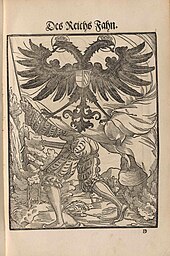

The flag of the Holy Roman Empire was not a national flag, but rather an imperial banner used by the Holy Roman Emperor; black and gold were used as the colours of the imperial banner, a black eagle on a golden background. After the late 13th or early 14th century, the claws and beak of the eagle were coloured red. From the early 15th century, a double-headed eagle[1] was used.
In 1804, Napoleon Bonaparte declared the First French Empire. In response to this, Emperor Francis II of the Habsburg dynasty declared his personal domain to be the Austrian Empire and became Francis I of Austria. Taking the colours of the banner of the Holy Roman Emperor, the flag of the Austrian Empire was black and gold. Francis II was the last Holy Roman Emperor, with Napoleon forcing the empire's dissolution in 1806. After this point, these colours continued to be used as the flag of Austria until 1918.
The colours red and white were also significant during this period. When the Holy Roman Empire took part in the Crusades, a war flag was flown alongside the black-gold imperial banner. This flag, known as the "Saint George Flag", was a white cross on a red background: the reverse of the St George's Cross used as the flag of Lombardy and England.[1] Red and white were also colours of the Hanseatic League (13th–17th centuries). Hanseatic trading ships were identifiable by their red-white pennants and most Hanseatic cities adopted red and white as their city colours (see Hanseatic flags). Red and white still feature as the colours of many former Hanseatic cities such as Hamburg or Bremen.
In northern Italy, during the conflict between the Guelphs and Ghibellines in the 12th to 14th centuries, the armies of the Ghibelline (pro-imperial) communes adopted the war banner of the Holy Roman Emperor (white cross on red) as their own, while the Guelph (anti-imperial) communes reversed the colours (red cross on white). These two schemes are prevalent in the modern civic heraldry of northern Italian towns and remains a revealing indicator of their past factional leanings. Traditionally Ghibelline towns like Pavia, Novara, Como, and Asti continue to display the Ghibelline cross. The Guelph cross can be found on the civic arms of traditionally Guelph towns like Milan, Vercelli, Alessandria, Reggio, and Bologna.
- ^ a b Holy Roman Empire at Flags of the World. Retrieved on 2008-02-26.